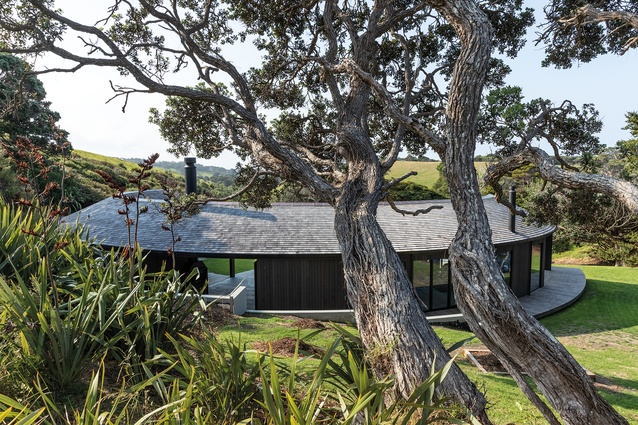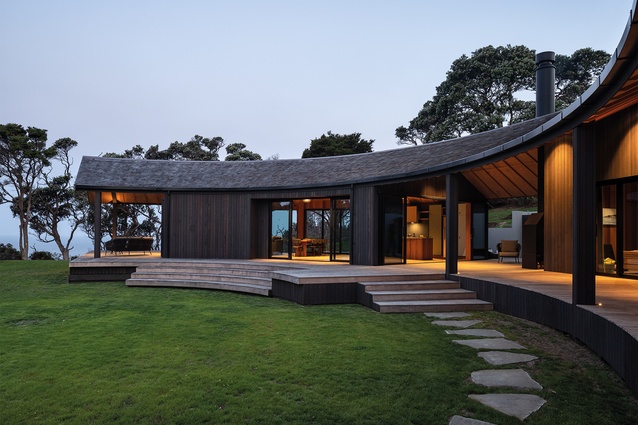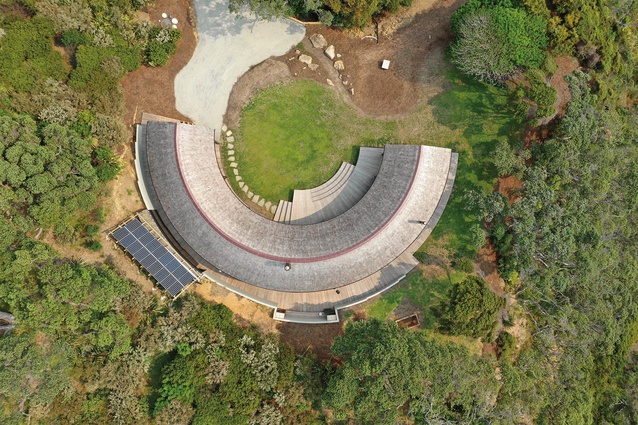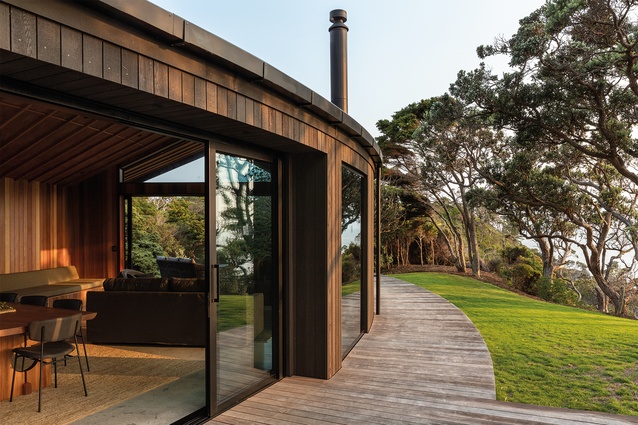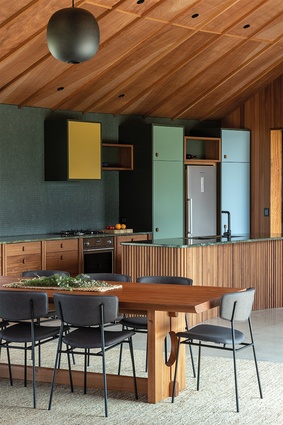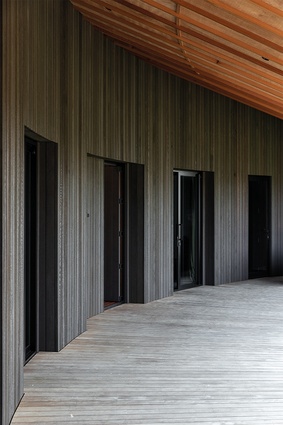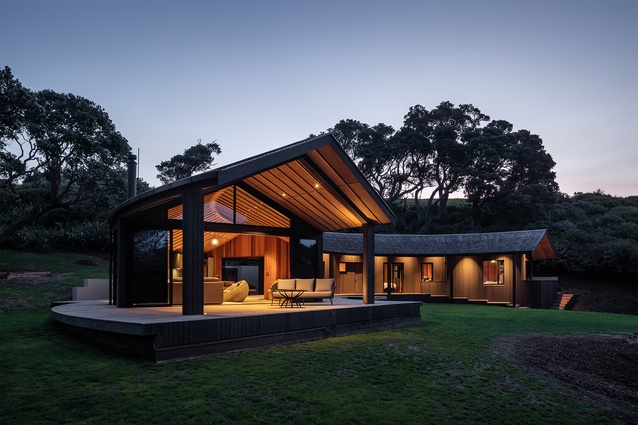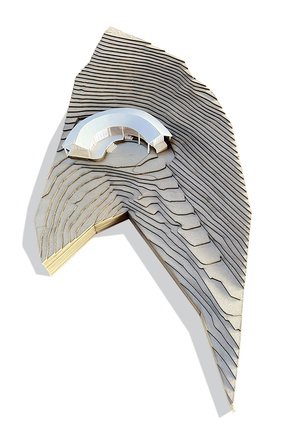Curved encampment: Bowden House
Jon Rennie finds delight in architect Belinda George’s elegant response to her client’s childhood memories of campsite living.
Amongst this year’s NZIA Auckland Local Architecture Housing shortlist – almost exclusively a mix of large houses in affluent suburbs and affluent holiday houses on beautiful coastlines – the Bowden house by Belinda George Architects, in association with Mandeno Design, is the most intriguing. The semicircular plan, timber shingle roof and diversity of pathways in the ‘hero’ photo above (not to mention the backgrounding of what is likely an epic coastal view) lead one to ask: “What is going on here…?”
This holiday house sits on a clifftop edge on the Tutukaka Coast, north of Whangarei, on the side of a hill that slopes down to the north and parallel to the sea. The house forms an enclosure with the bush that it faces – a feeling of encampment that the client wanted.
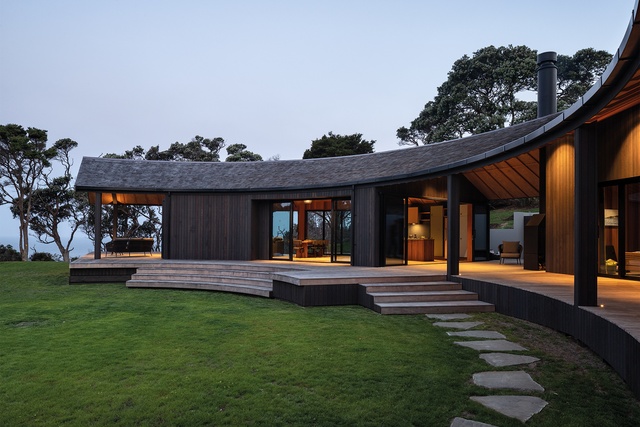
The social context and client’s connection to the site is eloquently described by George: “Fond boyhood memories of riding nikau palm fronds down the slope into this bush helped my client to select this particular site when the family farm was subdivided. Engaging with these memories was a key component of the brief.”
At the Bowden House, the sequence and type of spaces (three bedrooms, two bathrooms and kitchen/living/dining) is not unusual – an arrangement that places the main bedroom at one end and living space at the other. However, a simple plan move to arrange these spaces in a semi-circle delightfully resolves all the challenges of the site and brief: this curved plan provides outlook to the north and the native bush for both the main bedroom and the living space (the client’s desire was to focus on this, not the sea); these spaces also now both enjoy all day sun; and, the focus of all rooms is to a central communal space, consciously containing only lawn – observed by George as the primary surface of holiday activity and ‘where it all happens’.

In contrast to a rectilinear form running perpendicular to the slope of the hill, the semicircular plan enables two routes into and around the house – along the concave face (without impacting the privacy of the bedrooms) or between the house and the retaining wall to the hill. Although this is where the ancillary spaces are (outdoor equipment storage, PVs and batteries), the curved plan ensures this convex side is neither the ‘back’ nor secondary in either function or feeling. Along this route to the east, the building ‘peels away’ from the wall and reveals the view to the sea and the Poor Knights Islands beyond.
The only ‘room’ that connects the concave and convex sides of the house is the ‘courtyard’ – a roofed deck space that opens to both sides. Conceived as an acknowledgement to the client’s childhood spent sliding down the hill, it separates the bedroom and living wings and links the bush behind and the bush below.
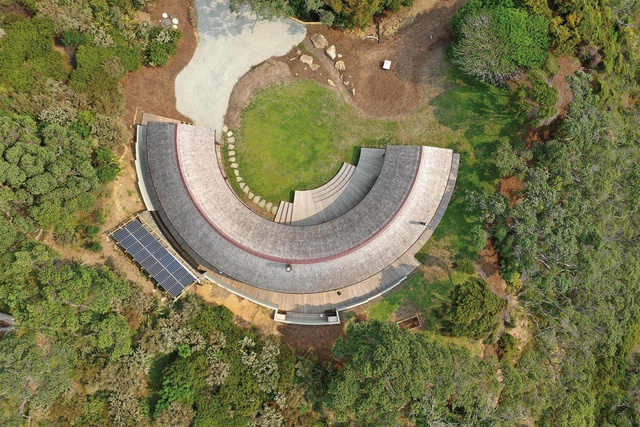
Having taken on the complexities of a circular plan, care has been taken not to overcomplicate it with extraneous parts or ‘too many notes’. As the house was being built, it became clear that the range of spaces that the form created provided numerous places for shelter throughout the day and wind screens to the courtyard were omitted. The material palette is reduced – perhaps the most singular material use in George’s work – and the colours are recessive. The windows are carefully composed and detailed to minimise the extent of aluminium and ensure they read as breaks in the wall.
The semi-circle has resolved the site and brief’s challenges exceptionally. In turn, the team involved have ensured that all the challenges that circles bring have been well solved: linear building materials, such as the decking, have been expertly crafted and tapered; straight windows have been sized to fit within the walls and so as not to ‘facet’ the form; and, the use of timber shingles resolve the concave and convex roof geometries perfectly (Alaskan yellow cedar has been used as it enables the rainwater to be collected and remain potable for this ‘off-grid’ house).
The resulting architecture is a strong reminder that a well-resolved plan of otherwise ‘usual’ spaces can lead to unique and enchanting outcomes – in this case, creating a sophisticated and atypical architectural response to a special coastal site.

